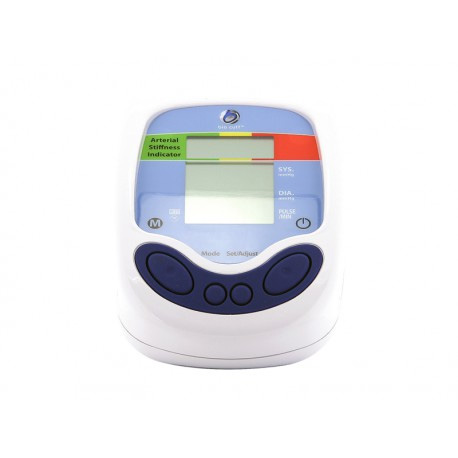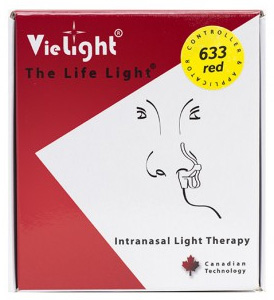
Rapamycin: a classic antiaging drug
June 5th, 2018By Marios Kyriazis, M.D.
Over the past several years there have been many significant discoveries regarding drugs which can affect the rate of aging. Research has sometimes led to confusing or conflicting results, but it is now becoming increasingly clear that certain agents have a definite action with regards to modifying the aging process. Examples include metformin, certain senolytics, carnosine, resveratrol, and mTOR inhibitors such as rapamycin, (note; the pharmacological inhibition of mTOR is an FDA-approved clinical principle).
mTOR (mammalian/mechanistic Target Of Rapamycin) is a well-known term to those who have an interest in the mechanisms of aging. In technical circles, mTOR is also known as the FK506-binding protein 12-Rapamycin-Associated Protein 1 (FRAP1), a term that has featured in increasingly more scientific papers in recent years. Basically, it is a kinase (a protein and, specifically, an enzyme) which is linked to a variety of other specific proteins and, together, they regulate cell function. Examples of processes which are regulated by mTOR include cell growth and motility, synthesis of other proteins, and importantly, autophagy (the process by which the cell degrades itself). The mTOR network senses signals from the environment, as well as signals originating from inside the cell regarding nutrition and energy requirements. Rapamycin is a well-known modulator of the mTOR process and it is the only existing pharmacological treatment which may increase lifespan in animals, including mammals (but not yet proven in humans) (1).
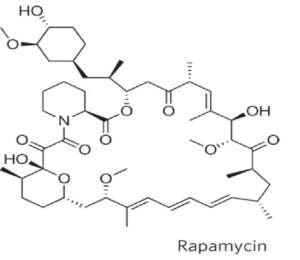
Apart from rapamycin itself, there exist several analogues which inhibit the immune response by blocking the proliferation of T-cells, by blocking the formation of new blood vessels (and thus block the blood supply to cancer cells), and by reducing the impact of inflammation.
The issue of side effects
A cause for concern has been the side-effects which are associated with the use of rapamycin and its analogues. Common side-effects include immunosuppression, lipid and glucose abnormalities and pneumonitis, all of which greatly depend on the dose used, and usually improve after the dose is decreased. These side-effects however may not be directly related to rapamycin itself. In clinical trials, the side-effects were more evident because rapamycin was given to already severely diseased patients who were also taking other drugs. Lower doses given to healthy patients for preventative purposes may not be associated with such side-effects. In addition, taking the drug in alternate dosing (one day on, the next day off) may still have positive benefits with an even lower risk of side effects.
However, there is still a lot to learn about the clinical use of rapamycin with regards to slowing aging in humans. Some of the difficulties include the different isoforms (variants) of the components which participate in the mTOR pathway, the exact location of mTOR complexes inside the cell, and other cell functions which depend directly or indirectly on the action of rapamycin.
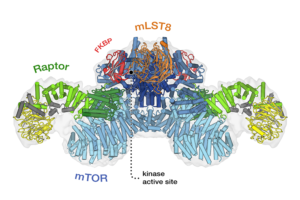
Senescence
For instance, and just to go into some detail, it is known that rapamycin interferes with senescent cells, which are cells that have lost their ability to divide any longer. These cells activate the senescence-associated secretory phenotype (SASP), which essentially creates a situation whereby normal cells cannot function properly and thus degeneration becomes evident. Rapamycin inhibits cell senescence through a complicated mechanism, and so it increases longevity (2).
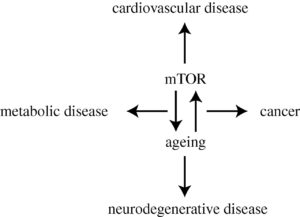
Rapamycin in Humans
While human trials specifically for preventing aging are missing, the following research may give us some useful insights regarding clinical use of mTOR inhibitors.
- Degeneration of neurons in mammals is associated with increased activity of mTOR, while inhibition of this prevents degeneration, at least in mice (3).
- Inhibition of mTOR in older people may improve the effectiveness of vaccines (4). This was particularly true in an experiment where response to the influenza vaccination was enhanced by 20% without significant side-effects.
- Rapamycin extended lifespan in mice acting directly on certain aspects of the aging process (and not simply by inhibiting cancer, or by improving immunity). The authors of this study (5) concluded that: “This study helps to further separate the life-extending effect of rapamycin from its cancer-preventing properties. Taken together, these findings indicate that rapamycin can be considered as a good candidate for a preventive anti-aging medicine”.
- In a study of everolimus, (a compound closely-related to rapamycin) in children, it was shown that it can dampen the excessive immune reaction following stem-cell transplantation, and so improved the clinical condition of the patients. This was clear in 93% of the patients. A common side-effect was increased triglycerides in the blood, which did not cause any clinical symptoms. It is important to remember that these patients were also treated with steroids, and thus we are facing the same situation regarding side-effects as was mentioned above. It may be that using mTOR inhibitors for prevention is associated with much less side-effects (6).
Natural mimetics of rapamycin
Researchers have tried to identify other compounds which replicate some of its physiological actions. In a recent study it was suggested that compounds such as epigallocatechin gallate, (in green tea for example), isoliquiritigenin (found in licorice), and withaferin A (used in Ayurvedic medicine) may act as mimetics of rapamycin (7). Another compound is oxaloacetate (oxaloacetic acid), which was featured in the Aging Matters™ magazine, issue 3, 2015.
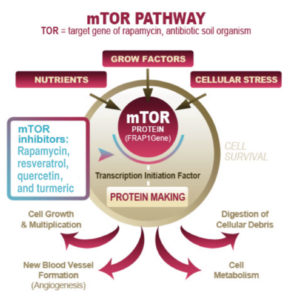
The bottom line
Rapamycin is a drug that has benefits and drawbacks. It is not a nutritional supplement to be taken without supervision. For the specific purpose of preventing age-related degeneration, it is used in low, irregular doses, closely monitoring its response and side effects. This can only be achieved with the help of a knowledgeable professional, and not by the patient on his/her own.
There is great potential in the clinical effects of this and similar drugs, but one must be able to separate hype from science, and not take sensational press news as true facts that are applicable on humans. There is a difference between using rapamycin for established illnesses (cancer) and using it for prevention in healthy people, to avoid aging.
Although in this article I am concentrating on rapamycin, this is not to say that it is one of the few potential treatments for aging. It is important to realize that aging will not be stopped using one, two or more kinds of different pills, but it is a matter of a wider approach, involving a generally appropriate lifestyle, positive attitudes, mental exercises, suitable exposure to positive stress, and many other interdependent factors and processes. In any case, rapamycin and its analogues or mimetics are useful agents to consider in this respect.
References
- Weichhart T. mTOR as Regulator of Lifespan, Aging, and Cellular Senescence: A Mini-Review. Gerontology. 2017 Dec 1. doi: 10.1159/000484629. [Epub ahead of print])
- Wang R, et al. Rapamycin inhibits the secretory phenotype of senescent cells by a Nrf2-independent mechanism. Aging Cell. 2017 Jun;16(3):564-574
- Hwang I, et al. FOXO protects against age-progressive axonal degeneration. Aging Cell. 2017 Nov 26. doi: 10.1111/acel.12701. [Epub ahead of print]
- Mannick JB, et al. mTOR inhibition improves immune function in the elderly. Science Translational Medicine 24 Dec 2014: Vol. 6, Issue 268, pp. 268ra179
- Roman V. Kondratov RV, Kondratova A. Rapamycin in preventive (very low) doses Aging (Albany NY). 2014 Mar; 6(3): 158–159. Published online 2014 Mar 22. doi: 18632/aging.100645
- Chao YH, et al. Everolimus for pediatric patients with acute graft-versus-host disease after hematopoietic stem cell transplantation: A pilot study. Medicine (Baltimore). 2017 Nov;96(44): e8464
- Aliper A, et al. Towards natural mimetics of metformin and rapamycin. Aging (Albany NY). 2017 Nov 15;9(11):2245-2268

